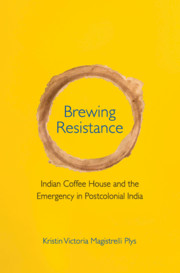Book contents
- Frontmatter
- Contents
- Acknowledgements
- 1 Introduction
- 2 How Anti-Colonial Labour Movements Create Anti-Authoritarian Autonomous Zones
- 3 Indira Gandhi’s Political Economy of Development
- 4 Social Movements of the 1970s
- 5 Emergency at Midnight
- 6 The Coffee House Movement
- 7 ‘Coffee House’ Workers’ Anti-Colonial Labour Movement
- 8 Conclusion
- Appendix I Photographs
- Appendix II Political Parties during the Emergency
- Appendix III Methodological Appendix
- Bibliography
- Index
1 - Introduction
Published online by Cambridge University Press: 12 May 2020
- Frontmatter
- Contents
- Acknowledgements
- 1 Introduction
- 2 How Anti-Colonial Labour Movements Create Anti-Authoritarian Autonomous Zones
- 3 Indira Gandhi’s Political Economy of Development
- 4 Social Movements of the 1970s
- 5 Emergency at Midnight
- 6 The Coffee House Movement
- 7 ‘Coffee House’ Workers’ Anti-Colonial Labour Movement
- 8 Conclusion
- Appendix I Photographs
- Appendix II Political Parties during the Emergency
- Appendix III Methodological Appendix
- Bibliography
- Index
Summary
when to be free
would cease to mean
the ones in power shall gain
delhi
you will cease to be.
—G. J. V. Prasad, Sati‘I am amazed at how many times in its centuries long journey Dilli has been plundered and resettled,’ wrote Intizar Hussein in Once There Was a City Named Dilli (2016: 6). Delhi has witnessed the rise and fall of Indraprastha, of the Delhi Sultanate, an invasion by Tamerlane, the rise and fall of Shahjahanabad, and then the Rebellion of 1857, the rise of Lutyens’ Delhi, Partition, and its aftermath. With each rise and fall of empire, ‘a new Dilli is inhabited in the midst of the old Dillis’ (Hussein 2016: 36). Each leader of this new city claims that ‘this Dilli will have such vigour and brilliance that all the preceding Dillis and the Dillis to follow will fade before it’ (Hussein 2016: 36). However, ‘not one of these cities was loyal to its founder … whoever built a new city on the land of Dilli would very soon have to lose it’ (Hussein 2016: 46). Ahmed Ali, in the introduction to his novel Twilight in Delhi (1940), describes how after Partition, the new state of India, continuing in the British legacy, moved Delhi further away from its designation as the Mughal capital, Shahjahanabad, towards Indraprastha, the ancient seat of the Hindu empires rumoured to have been located in what is now called Delhi. Ali writes, ‘Seven Delhis have fallen, and the eighth has gone the way of its predecessors, yet to be demolished and built again. Life, like the Phoenix, must collect the spices for its nest and set fire to it, and arise resurrected out of the flames’ (1940: 20). The Emergency created yet another Delhi built by Indira Gandhi, and just two years later, another fallen Delhi with the election of the Janata Party in 1977. But what was resurrected from the flames this time?
Delhi has been the capital of several historical world-empires and states. It is a place where many political fortunes rose and fell. Political change
- Type
- Chapter
- Information
- Brewing ResistanceIndian Coffee House and the Emergency in Postcolonial India, pp. 1 - 19Publisher: Cambridge University PressPrint publication year: 2020



